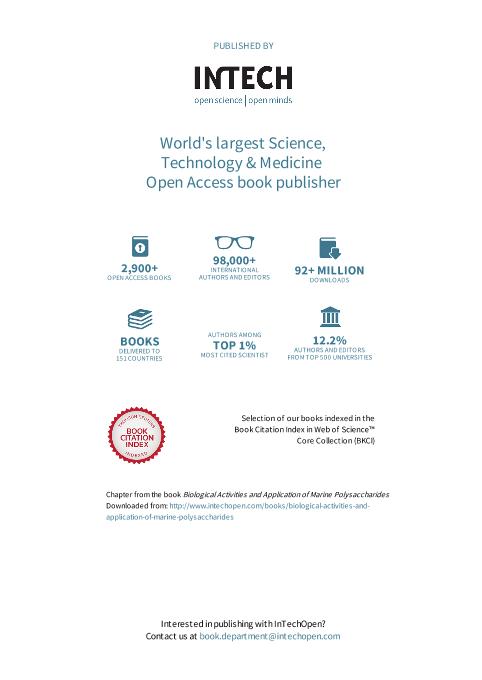Mostrar el registro sencillo del ítem
dc.contributor.author
Dima, Jimena Bernadette

dc.contributor.author
Sequeiros, Cynthia

dc.contributor.author
Zaritzky, Noemi Elisabet

dc.contributor.other
Shalaby, Emad A.
dc.date.available
2021-08-05T12:19:10Z
dc.date.issued
2017
dc.identifier.citation
Dima, Jimena Bernadette; Sequeiros, Cynthia; Zaritzky, Noemi Elisabet; Chitosan from Marine Crustaceans: Production, Characterization and Applications; IntechOpen; 2017; 39-56
dc.identifier.isbn
978-953-51-2859-5
dc.identifier.uri
http://hdl.handle.net/11336/137841
dc.description.abstract
Chitosan is a very useful marine polysaccharide that forms structural components in the exoskeleton of crustaceans. In this chapter, the production of chitosan (CH) and chitosan reticulated micro/nanoparticles (CHM) is described. Three case studies corresponding to different effective applications of chitosan are discussed: (i) the performance of CH to destabilize oil/water emulsion waste for water clarification. It was observed that as long as colloidal charge was maintained around zero, turbidity also showed low values and water clarification was achieved. However, when the applied doses were higher than the optimum, colloidal charge and turbidity both increased, showing emulsion restabilization. Emulsions treated with the optimum chitosan doses were clarified in very short periods; (ii) CH and CHM were used as effective antibacterial agents against three different pathogenic microorganisms that are problematic for aquaculture: Vibrio alginolyticus and parahaemolyticus, and Lactococcus garvieae and theminimum bactericidal concentrations were determined; and (iii) the removal ofhexavalent chromium and the comparative performance of CH versus CHM. Resultsshowed that at pH < 2, the adsorption capacity of CHM was higher because CH isunstable. Additionally, Cr(VI) was adsorbed on CH without further reduction; incontrast, Cr(VI) adsorbed on CHM was reduced to nontoxic Cr(III).
dc.format
application/pdf
dc.language.iso
eng
dc.publisher
IntechOpen

dc.rights
info:eu-repo/semantics/openAccess
dc.rights.uri
https://creativecommons.org/licenses/by-nc-sa/2.5/ar/
dc.subject
CHITOSAN
dc.subject
COAGULATION
dc.subject
FLOCCULATION
dc.subject
ANTIMICROBIAL PROPERTIES
dc.subject
AQUACULTURE
dc.subject
HEXAVALENT CHROMIUM REMOVAL
dc.subject
MICRO AND NANOPARTICLES
dc.subject.classification
Ingeniería de los Materiales

dc.subject.classification
Ingeniería de los Materiales

dc.subject.classification
INGENIERÍAS Y TECNOLOGÍAS

dc.title
Chitosan from Marine Crustaceans: Production, Characterization and Applications
dc.type
info:eu-repo/semantics/publishedVersion
dc.type
info:eu-repo/semantics/bookPart
dc.type
info:ar-repo/semantics/parte de libro
dc.date.updated
2021-07-30T18:07:04Z
dc.journal.pagination
39-56
dc.journal.pais
Estados Unidos

dc.description.fil
Fil: Dima, Jimena Bernadette. Consejo Nacional de Investigaciones Científicas y Técnicas. Centro Nacional Patagónico; Argentina
dc.description.fil
Fil: Sequeiros, Cynthia. Consejo Nacional de Investigaciones Científicas y Técnicas. Centro Científico Tecnológico Conicet - Centro Nacional Patagónico. Centro para el Estudio de Sistemas Marinos; Argentina
dc.description.fil
Fil: Zaritzky, Noemi Elisabet. Provincia de Buenos Aires. Gobernación. Comisión de Investigaciones Científicas. Centro de Investigación y Desarrollo en Criotecnología de Alimentos. Consejo Nacional de Investigaciones Científicas y Técnicas. Centro Científico Tecnológico Conicet - La Plata. Centro de Investigación y Desarrollo en Criotecnología de Alimentos. Universidad Nacional de La Plata. Facultad de Ciencias Exactas. Centro de Investigación y Desarrollo en Criotecnología de Alimentos; Argentina
dc.relation.alternativeid
info:eu-repo/semantics/altIdentifier/url/https://www.intechopen.com/chapters/52367
dc.relation.alternativeid
info:eu-repo/semantics/altIdentifier/doi/http://dx.doi.org/10.5772/65258
dc.conicet.paginas
326
dc.source.titulo
Biological Activities and Application of Marine Polysaccharides
Archivos asociados
